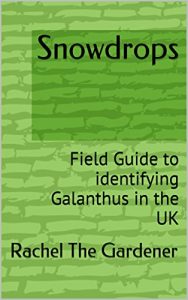“A Snowdrop is a Snowdrop, isn't it?”
Yes, but they are more interesting than you might think: for a start, did you think that they had white petals? Well, they don't!
And you probably already know that there are thousands of cultivars of Snowdrops, but the good news for Field Botanists is that most of the ones you will find in the wild belong to one of only three species (that word is singular and plural, confusingly) and this Crib carefully explains the differences between them, as well as describing how to distinguish between applanate and convolute leaves – something you have no doubt always wanted to know.
So, download this book, study the Crib, and then, season permitting, of course, get out there and look for them! Snowdrops are found all over the place in the wild - in hedgerows and along footpaths, and they often form large colonies in woodlands and open areas, making it easy for Botanists to study them.
This Field Guide is one of a series of books intended for use in the field by UK Botanists, both Improvers and complete beginners, to help swiftly narrow down the identification of a plant, and to extend your knowledge and understanding of the genus.
They cover commonly found UK species, and are not intended to replace a full-length Field Guide such as Poland or Rose: but they present the salient information in an easy-to-read format, to people who have gone beyond having to key out every single plant, and who are now trying to learn the difference between species.
The Kindle is the perfect format for this, as you can look up any words you don't understand in the Kindle dictionary, and then annotate the Table to remind yourself.
Originally they were in the form of a pack of A6 cards on a ring, and you may prefer to print out the Crib to take with you: but if you can take your Kindle out botanising with you, then so much the better!
Yes, but they are more interesting than you might think: for a start, did you think that they had white petals? Well, they don't!
And you probably already know that there are thousands of cultivars of Snowdrops, but the good news for Field Botanists is that most of the ones you will find in the wild belong to one of only three species (that word is singular and plural, confusingly) and this Crib carefully explains the differences between them, as well as describing how to distinguish between applanate and convolute leaves – something you have no doubt always wanted to know.
So, download this book, study the Crib, and then, season permitting, of course, get out there and look for them! Snowdrops are found all over the place in the wild - in hedgerows and along footpaths, and they often form large colonies in woodlands and open areas, making it easy for Botanists to study them.
This Field Guide is one of a series of books intended for use in the field by UK Botanists, both Improvers and complete beginners, to help swiftly narrow down the identification of a plant, and to extend your knowledge and understanding of the genus.
They cover commonly found UK species, and are not intended to replace a full-length Field Guide such as Poland or Rose: but they present the salient information in an easy-to-read format, to people who have gone beyond having to key out every single plant, and who are now trying to learn the difference between species.
The Kindle is the perfect format for this, as you can look up any words you don't understand in the Kindle dictionary, and then annotate the Table to remind yourself.
Originally they were in the form of a pack of A6 cards on a ring, and you may prefer to print out the Crib to take with you: but if you can take your Kindle out botanising with you, then so much the better!






